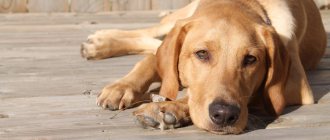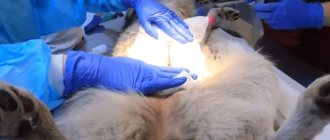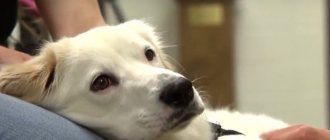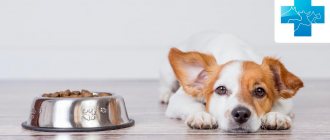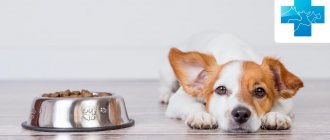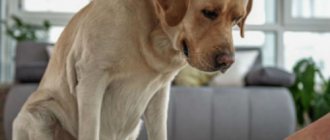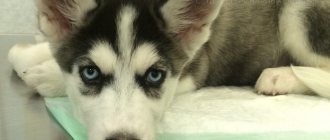A blanket for a dog is considered not only a means of protecting wounds during the postoperative period, but also a mandatory element of the wardrobe. Blankets vary in purpose, which is why they are sewn from different materials. They can be cotton, nylon, fur. There is an opinion that they are identical to overalls, but this is not so. Blankets are positioned as loose-fitting clothing. It does not restrict the pet’s movements in any way, so he can enjoy active running and playing with his owner.
Caring for a dog after sterilization on the first day
The first day after sterilization is especially important for the animal.
When recovering from anesthesia, the dog may behave inappropriately, may pee under itself, or fall out of a chair or bed. For this reason, it should not be placed in elevated places. The bed must be covered with a sterile disposable diaper (sold in pharmacies) and changed regularly when it gets wet. Sterilization operation
Important! If urinary incontinence occurs for a long time after the release of anesthesia, consultation with a veterinarian is necessary.
The place for the operated dog should not be in a passage, in a draft, or near heating devices. It is advisable to cover the bitch with something warm on top so that she does not get pneumonia, since at this time the body temperature drops and life processes slow down.
Anesthesia after surgery usually wears off within 2-3 hours, but it will take at least a day for the dog to finally come to its senses. At this time, you should not leave the dog for a long time. Anesthesia can cause panic in an animal, a feeling of anxiety, and unreasonable aggression. This is not something to be afraid of. Everything will return to normal as soon as the anesthesia completely leaves the body. At this time, you need to stay close to your pet, create a quiet, calm environment for him, and warn your family not to disturb him.
Note! The answer to the question of how long it takes a dog to recover from anesthesia after sterilization depends on the drug administered, its dosage, and the characteristics of the animal’s body.
Preferred castration method
In Russia, only 2 methods are used: abdominal and laparoscopic. In the first case, the surgeon uses a regular scalpel, and in the second, a special endoscope for the abdominal cavity, or laparoscope.
Laparoscopy is more expensive, but the high price is well justified. The endoscope allows you to reduce the size of the incision, which reduces the risk of heavy blood loss and other complications.
Recovery after such an operation is easier, but only a limited number of clinics offer it. This is due to the high cost of the equipment and the lack of a sufficient number of doctors who know how to use it.
Dog blanket pattern
Let's look at how to design a pattern.
First of all, you need to measure the length of the dog's back from the neck (where the collar goes on) to the base of the tail.
Next we need to create a pattern of the required size. To do this, divide the length of the pet's back by 10 and get the size of the side of the square for constructing the pattern.
For example, the length of Jack's back is 30 cm. I divided 30 by 10 and got the size of the side of the square for my pattern - 3 cm. You should get your own square size, depending on the length of your doggie's back.
Draw a grid of squares on lined tracing paper (or just on checkered paper). Have you drawn it? Next, we look at the sample and transfer the pattern directly into the cells onto our “grid”.
For the upper part of the pattern (back), the grid should consist of 7x13 squares.
For the lower part of the pattern (tummy), the grid should consist of 7x10 squares.
When the dog blanket pattern has already been drawn, you can cut it out and go to the store to select fabric.
Consequences of sterilization
After the procedure, the dog will never be able to become pregnant or bear offspring, and the concentration of estrogen produced is reduced to the minimum required for the full functioning of the body.
After sterilization, your pet may experience weight gain. In order to prevent obesity and diabetes, you need to provide him with proper care by reviewing his diet and increasing the duration of walks.
Sterilization cannot have any effect on character and behavior. So, for example, the dog will remain as cheerful and active as it was before the operation.
The need for blankets
Cat after sterilization: care at home
After the sterilization operation and treatment of the sutures, in order to prevent infection from entering the wound, the dog is put on a special blanket, and, if necessary, a collar. A postoperative blanket is also necessary to prevent the dog from licking the seam. It also supports the abdominal cavity, preventing the formation of hernias and suture divergence.
The blanket should always be clean. When going outside with your pet, it should be protected with a jumpsuit, and if it gets dirty, change it for a clean one. During a winter walk, the blanket is insulated on top to prevent the seams from getting cold. This accessory is worn, if there are no complications, for 2-3 weeks. During this time, the pet should not be subjected to physical stress.
Postoperative blanket
The dog may not like wearing foreign things; it will try to take it off, refuse to eat, and in every possible way show inconvenience in movement. You should not follow the dog’s lead, as this is fraught with bad consequences. While your pet is recovering, wearing a blanket is essential.
Physical activity and walks
After surgery, physical activity is not allowed. You can go outside approximately 10 days after sterilization, depending on the dog’s condition. The walk should be short, at a calm pace, without unnecessary activity. The owner’s task is to protect the dog from encounters with aggressive animals, jerks and other surprises. Otherwise the seams may come apart. It is also important to prevent dirt and snow from getting into the wound area, and do not walk on tall grass.
On average, after a month the dog can return to normal life. But it is better to check this period with your veterinarian.
How to wear a blanket
How to put a vest on a dog without any problems:
- We place it above the dog.
- We put a collar on the dog's head, tucking the edges.
- We pass the blanket through the ears, lifting one paw - these ears should be under the pet.
- We fix the ears on the back, fixing the required volume with Velcro.
- We put elastic bands on the hind legs, if necessary, we adjust the drawstrings along the edge of the clothes.
We recommend that you learn how to choose a collar, harness, muzzle, and bowl for your pet
- In case of bad weather, you need to cover the dog's ears, raise the collar.
- We remove the clothes in the reverse order: first, elastic bands from the hind legs, then unfasten the blanket ears on the back, and finally, pull the collar off the head.
Choosing a ready-made bandage in the store
In fact, there are dozens of offers on the market today and the only task facing the owner is choosing the appropriate size (and not choosing a brand, as many might think). Today there are seven sizes of the standard dog brace. And here’s how to choose the right one, based on the size of your pet:
- XS. This is the smallest, first size. Accordingly, it is suitable for lap dogs, dachshunds, Pekingese, etc. If we talk about the dog’s chest size, it should be no less than 37 cm and no more than 47 cm.
- S. This is, accordingly, the second size. Also intended for "trifles". Suitable for many terriers, French bulldogs, some pugs and similar sized dogs. Bust circumference – from 47 cm to 57 cm.
- M. Third size. Suitable for dogs with chest girth from 57 cm to 67 cm. Suitable for almost all medium breeds in their “lower range”, i.e. it can be put on English bulldogs, pit bulls, etc.
- L. Size four. It is considered the most versatile and popular. Chest circumference – from 67 cm to 77-79 cm. Used for huskies, setters, many medium-sized shepherd dogs, etc.
- XL, size five. Used for dogs with a chest circumference from 79 cm to 89-90 cm. Accordingly, it is also designed for large representatives of medium breeds (such as collies and other shepherd dogs).
- XXL, size six. Suitable for large dogs with chest circumference from 90 cm to 101-102 cm.
- XXXL, size seven. As you can easily understand, it is intended for representatives of large and especially large breeds with a chest circumference of up to 116-120 cm.
Seam processing
At home, the sutures of the operated animal are regularly treated with a disinfectant, then with an ointment or aerosol 2 times a day until they are completely healed. The crusts formed after the operation are moistened with hydrogen peroxide until they soften, then removed.
After sterilization, the cat asks the cat: is this normal and what to do?
If the wound is poorly treated or licked, an inflammatory process may begin. When an infection gets into the wound, the animal vomits, the temperature rises, increased thirst appears, and the heartbeat quickens. Such symptoms require immediate medical examination and a course of antibiotics.
Note! If your dog whines after sterilization or is in pain, you can give painkillers after consulting with your doctor.
Postoperative sutures
When is it time to remove stitches and how does it happen?
The sutures are removed when the wound has healed completely. First, the animal is restrained, since the procedure, although not painful, is unpleasant. Then the doctor treats the skin in the suture area with an antiseptic, cuts the thread with scissors and removes it with tweezers. A cosmetic suture made from absorbable threads does not require removal.
As you can see, caring for your dog after surgery is necessary, but there is nothing terrible about it. A loving owner will need time, patience and strict adherence to the veterinarian’s instructions, then healing will be painless for everyone.
How to put on a postoperative blanket correctly?
- The first step is to place the material directly under the dog's belly.
- The blanket has several ties for fastening. They need to be secured sequentially, starting from the neck and moving towards the tail of the animal.
- Two ties cross just above the abdominal cavity. This is necessary so that the animal does not remove the foreign body.
- The last ties need to be passed between the hind limbs of the animal and secured to each other.
It is very important that the blanket does not tighten the animal’s body too tightly, but at the same time it fits snugly to the stomach. If you fasten the fabric too tightly, it will be difficult for the animal to breathe and, in addition, you may damage the stitches on your pet's wound. If the blanket dangles on the animal’s body, then the dog can easily remove it, and then there will be much more problems.
But what to do if a cable or catheter is inserted into your pet’s abdomen?
In this case, the blanket has special cutouts through which the wire can be passed while maintaining the integrity of the material. If there are no special holes in the part where the catheter is installed, you can make them yourself and pass them through the blanket in the same way.
If it's too big for your pet and no matter how tight you pull it still flops around, you can make additional cuts along the tie line. This will help you adjust the fabric to the correct size for your dog. In principle, the technique for using this protective clothing is simple, but it is worth emphasizing a few important points. Remember that:
- It is necessary to secure the blanket tightly on the pet's belly.
- It often happens that animals cannot get used to this fabric and constantly try to remove it or chew it. In this case, you will have to resort to additional measures to protect your dog's health. Buy a special protective collar from your nearest veterinary pharmacy and attach it to your pet’s neck. This will speed up the healing process.
- If your dog behaves very nervously and aggressively during the first few days, don’t be surprised. This is all due to lack of habit. However, if your pet's anxiety does not subside on the third or fourth day after surgery, take him to a veterinary hospital. Perhaps the operation was not entirely successful, or the stitches are causing too much trouble. Let the doctor take a look and determine the cause of the animal’s anxiety.
- Do not remove the blanket without first consulting a doctor. Usually, veterinarians themselves warn when the protective mechanism can be removed. This is exactly the case where you should not take the initiative.
General recommendations
The dog blanket is quite simple in its design, so you can purchase it without first trying it on. The owner only has to indicate the body parameters. Measurements are taken from the part of the body that connects the head and torso to the base of the tail. Since the volume of clothing can be adjusted slightly above the stomach, this is enough to choose the right size. Some owners, in order to save money, prefer to sew clothes for their pet with their own hands. It’s easy, and patterns can be found freely available on the Internet, the only thing you need to do is take a few measurements. It is important to consider the width of the chest and the length of the torso.
Why was a dog blanket invented?
The blanket was invented by horse owners solely to keep them healthy; the clothing absorbs sweat, while the fabric protects the main muscle groups from hypothermia. Therefore, the attribute can be easily removed and just as quickly put on, while the pet’s movements will not be constrained, the cape will not put pressure on the chest, will not slip or bunch up like an accordion. If the dog is very active outside, it is rational to purchase a blanket made of microfiber, fleece, or cotton equivalents. A warm blanket for dogs is useful in winter; it can be made of natural or artificial wool.
It is not always possible to see how high-quality the material is by eye, but before purchasing, the owner should pay attention to the fasteners - fastex, zippers, belts, buckles. You need to make sure that nothing sticks, creaks, or unfastens on its own. Often, to fix the cape, manufacturers use Velcro. This is very convenient and functional in winter, because at sub-zero temperatures, plastic locks cannot always withstand the fleecy part well. Quality can be checked by external and internal seams. Threads that stick out in different directions, broken uneven seams, unnecessary stitches should put you off buying.
Features of skin and coat care
Due to the removal of the uterus and gonads, a hormonal imbalance occurs in the body, which in turn leads to disruption of the natural change of hair and undercoat. Shedding of hair in bitches usually occurs after the cessation of estrus.
Chihuahua: care and maintenance at home
In the absence of estrus as a result of surgical intervention, the body stops sending signals about a change in coat, the fur begins to grow randomly and profusely, which leads to a change in the appearance of the pet. In this case, the dog needs additional care for its coat.
Note! Skin and coat care depends on the dog's breed and coat type.
Short-haired dogs, such as Dobermans, dachshunds, Dalmatians, pugs, and hounds, are not subject to any special changes in their coat. In long-haired breeds with undercoat, such as Akita Inu, Husky, Spitz, Corgi, Shepherd, a side effect of sterilization can be an abundant growth of undercoat, which requires frequent combing or plucking.
In dogs such as the Poodle, Yorkshire Terrier, Bichon Frize, and Maltese, the outer coat and undercoat differ little from each other; they do not undergo significant changes during sterilization.
Most often, the coat of dogs with a mixture of long and short hair undergoes changes. These include spaniels, retrievers, setters, greyhounds, Pekingese, Japanese chin and others. Their fur becomes softer, so it mats quickly and difficult to comb tangles form. As a result, the dog's appearance suffers. In this case, the wool requires additional care.
Grooming
The hard, wiry coat of Shih Tzus, Giant Schnauzers, Afghan Hounds, and some types of terriers also suffers. As a result of sterilization of the animal, it loses its natural rigidity, becomes softer, and requires cutting with scissors instead of the usual trimming, which can only increase the growth of fluffy and soft fur.
Features of the recovery period after fractures and joint surgeries
How is the rehabilitation period after limb fractures and knee surgery? The duration of recovery depends on the complexity of the injury. After cracks, simple fractures, sprains, you can walk the dog already 4-5 days after discharge. Injuries to the hip or knee joint take much longer to heal. The animal should be given a massage and exercise therapy with it. To reduce the load, they buy a special stroller.
The damaged limb is fixed with a rigid bandage, which supports the ligaments and prevents the displacement of broken bones. For the time being, the dog should be limited in any type of physical activity, including daily walks.
Nutrition during the recovery period
You can feed your dog no earlier than 10 hours after sterilization. Before feeding, fluids must be provided. After surgery, dogs often experience constipation, which is accompanied by pain. This must be regulated with nutrition until digestion is restored.
Food should be given in a pureed, semi-liquid state in small portions, but often. The food should be well balanced and include dairy products. If the dog refuses to eat and only drinks water, there is no need to force it to eat. You should start to worry if your pet refuses to eat food for more than three days.
How often should you visit the vet after surgery?
The dog does not need extra visits to the clinic during the postoperative period. During the trip, there is a chance that the wound will be disturbed, and in the clinic itself you will encounter an infection. If the veterinarian has not recommended anything else and healing is proceeding without problems, you can only get by with a visit to remove the stitches after 14 days. Your veterinarian may also suggest tests and an ultrasound to make sure healing is successful.
In rare cases, the bitch remains in heat after surgery. This means that the ovary was not completely removed. An additional visit to the doctor will be required to examine and correct the situation.
Possible complications in a dog after castration
After castration, the animal may lack appetite. The reason for this may be the blanket. In such cases, it is removed for feeding and then put on again.
When processing seams, you should pay attention to the color of your pet's skin. Its pale appearance may indicate internal bleeding, which may occur due to poor blood clotting or inept actions of the operating veterinarian.
Another complication after surgery can be ruptured internal sutures. Lumps under the skin are formed as a result of the prolapse of internal organs beyond the walls of the abdominal cavity. Also, after anesthesia, problems with the knee joints are possible.
Danger signs: when to go to the vet
As a rule, veterinarians themselves draw the attention of owners to signs that the dog needs urgent help. Many even issue a special reminder. You should be wary:
- long sleep after anesthesia;
- high or low temperature in the dog;
- difficulty or uneven breathing, fainting;
- pale to blue mucous membranes;
- separation, redness, suppuration of the suture, increase in its temperature;
- the appearance of cones (hernias) at the suture site.
In these cases, you must urgently contact your doctor and be ready to go to the clinic.
Postoperative abdominal bandage - all the most important things
The abdominal bandage is a wide belt made of special elastic materials. The bandage performs the functions of the anterior abdominal wall of a person if the wall itself is damaged, as in the case of a hernia or postoperative suture.
Why do you need a bandage?
Before surgery
Used for abdominal hernias, in the period before surgical treatment of the hernia. Because It is not always possible to perform surgery immediately after diagnosis; a bandage is needed to:
- Hold the hernia and prevent strangulation
- Prevent hernia enlargement
- Reduce and eliminate pain
- Protect against complications (irreducibility, inflammation)
After operation
A bandage is necessary after any operation on the abdominal wall in order to:
- Ensure high-quality, correct and safe restoration of abdominal wall functions
- Protect the seam from pressure during the slightest physical activity (getting out of bed), any straining (for example, coughing) and provide the seam with the opportunity to quickly scar
- Support internal organs in anatomically correct position
- Reduce pain and prevent the risk of hernias
How to choose a bandage
Like any medical product, the bandage is selected strictly in accordance with certain parameters.
How to choose the right bandage - watch the video
How to use the bandage
- The bandage begins to be used immediately after the operation.
- The postoperative bandage should be put on while lying down. You first need to relax so that the internal organs take the correct anatomical position. Fasten tightly, but in such a way that the bandage does not interfere with breathing.
- It is better to wear the bandage on cotton clothing (if possible, seamless). In some cases, the doctor may recommend wearing it on the naked body, but in this case it is worth considering a spare model in order to maintain the proper level of hygiene.
- Constant wearing of the bandage can last from one week to one month. This period should be sufficient for the threat of suture dehiscence to pass and the position of the internal organs to stabilize. The duration of wearing the bandage and the time of breaks are recommended by the doctor, depending on the severity of the surgical intervention and the patient’s condition.
- The bandage must be removed at night unless otherwise indicated by a doctor.
- In the future, wearing the bandage becomes not permanent and can last from 3 to 6 months. The brace must be worn during physical activity. This could be housework, shopping, or more serious activities.
- In the long-term postoperative period, you cannot constantly wear a bandage, as the risk of muscle tissue atrophy increases.
Types of postoperative bandages:
- Ostomy bandage
- Used in the postoperative period for patients with a stoma or when using drainage devices, as well as to prevent the formation of hernias in the stoma area.
- Compression bandages
- Used for women after wearing a postoperative bandage (in some cases instead of it), for comfort in later stages of recovery, prevention of the formation of postoperative hernias, restoration of the muscle corset, during the period after childbirth and liposuction.
NOTE!
It is recommended to use it simultaneously with a bandage during surgery.
hospital knitwear
, which you can learn about in the article The most important thing about hospital knitwear
Chest measurement, material selection
As we have already said, when purchasing or even making a bandage yourself, you need to know its size. And to do this, you need to correctly measure the circumference of your pet’s chest. In general, this is easy to do: using a measuring tape, you need to measure the widest place just behind the front paws. And another useful tip: buy or make a blanket before the operation. This will save a lot of time and nerves.
The second point is the selection of material. Experienced breeders and veterinarians, in general, are unanimous on one thing: you should buy or make blankets yourself only from pure, high-quality cotton. He breathes perfectly, allowing air to pass through. If this is not possible, you should select fabrics with the maximum content of cotton. Under no circumstances should you buy “consumer goods” made from pure synthetics, since the post-operative sutures underneath get wet and “steam”, which sharply increases the likelihood of developing post-operative complications.
When is a veterinarian needed?
In general, animals tolerate sterilization without complications. But there are times when the help of a veterinarian is necessary. Such cases include:
- lack of urination for more than a day;
- absence of stool for more than 2 days or the presence of blood in the stool;
- pale or bluish skin;
- cardiopalmus;
- convulsions, fainting;
- difficulty breathing with an open mouth, wheezing;
- increase or decrease in temperature.
The reason for contacting a veterinarian is also suppuration of the wound, bleeding from it, vomiting, prolonged apathy, and lethargy.
Many postoperative complications can be avoided by strictly following the rules of care, a detailed list of which can be obtained from a veterinary clinic. If any deviations in the animal’s behavior are observed, it is necessary to immediately show it to a doctor and undergo a course of treatment.
Complications
Despite the fact that castration is not considered one of the most difficult operations, a number of complications can still arise after it. To minimize this risk, you must take into account the recommendations and advice of your veterinarian.
The following problems often arise:
- Sometimes in the first days the pet becomes constipated. In this case, you need to reconsider his diet. It should only contain liquid food.
- Lack or decreased appetite. For the first 2-3 days this is normal, but then it requires the help of a veterinarian.
- Drowsiness and weakness.
- Poor orientation on the ground, especially on the first day.
These symptoms usually go away on their own. But there are signs that indicate the presence of serious problems and require contacting a clinic:
What is not normal? There are several reasons to worry about your animal:
- Continuous shaking and convulsions;
- The heart beats too fast or too slow;
- Uneven, rapid breathing, wheezing.
The doctor should explain what is normal, but if you are concerned about the animal’s condition, you should immediately contact a veterinarian.
Having woken up from anesthesia, the dog will try to get to its feet, stagger, try to walk, and often the pet may vomit, all this is normal, but this part of the rehabilitation requires special attention. The pet is disoriented and at this time may become injured, not respond to the owner or react inappropriately, get scared, or become aggressive. It is worth showing understanding and trying to surround the dog with calm, give it some more rest, carefully monitor and secure the environment around it so that the pet does not get stuck anywhere or fall from a height. You cannot feed or water the dog at this time; you can give it water when it is stable on its feet and moving around.
How to sew a bandage
How to properly tie a postoperative blanket on a cat after sterilization; is it possible to sew it with your own hands?
A post-operative bandage can be made at home. It is advisable to have a sewing machine at your disposal. The material from which you are going to make the bandage should be durable, but breathable. If the dog is very active, it is better to use summer jeans.
The pattern is made according to size. Please note that the blanket must be worn on the hind and front legs. If the bandage is not on the hind legs, the dog can easily remove it. The ties should be done on the back. You can use laces, Velcro or buttons for fastening.
The bandage should not squeeze the dog’s body, but it is also highly undesirable for it to dangle. The pattern is an X-shaped pattern. The whole part is the belly. When preparing a pattern, take into account the allowances; the raw edges stretch after the first wash.
When preparing to sterilize your dog, keep in mind that there must be at least two blankets. After washing, the bandage must be ironed. It is not advisable to use household chemicals for washing, even for children.
Rigid bandages to support or protect joints
Active pets often get injured while walking - an unsuccessful jump, playing too enthusiastically with their relatives, an untimely turn while running, or simply a bump on which the dog twists its paw. A sprained or torn tendon is a painful injury that requires the joint to be free of weight, meaning the dog must not be able to bend or straighten the limb.
For joint injuries, a rigid bandage is used, which is fixed around the injured area with Velcro. When an unsuccessful jump occurs, the joints on the front legs most often suffer. After examination by a veterinarian, a rigid belt is placed on the dog’s paw and tightened to a reasonable maximum. The owner needs to strictly monitor the limb; swelling or swelling are signs of circulatory problems, which can have serious consequences. If the hock joints are damaged, bandages are placed on the hind legs.
In addition to joint bandages, there are support belts, corsets and vests. Pets with a disproportionate body structure, especially dachshunds, are prone to joint dysplasia and various pathologies of the spinal region. A veterinary examination may reveal that the dog is experiencing back pain, although it may not be noticeable externally. A bandage for a dog with spinal problems is prescribed both when symptoms of the disease appear and for prevention.
Types of blankets and their purpose
Pet stores offer a large selection of blankets for cats. They differ from each other not only in size, but also in the material of manufacture, cut and purpose. So, protective clothing for cats is divided into:
- Warm blankets for protection from the cold. Mainly used for short-haired breeds of cats and sphinxes. Owners put sleeveless vests on their pets when taking them for a walk.
- Blankets for the home, in order to protect the owners from the shedding of the animal. This is especially true for people sensitive to various allergens. In addition, many owners do not want to constantly clean the apartment from a large amount of wool. Sphynxes also wear light cotton blankets to protect their furniture from stains. The fact is that hairless cats have an unpleasant feature - high sweating. Therefore, light clothing or a sleeveless T-shirt copes well with discharge and heavy shedding of fur. Some models of home blankets are also necessary for caring for seriously ill pets. In cats with tumors of the mammary glands, in order to avoid scratching the affected area, the owners put a blanket on their four-legged friend for constant wearing. For ease of wearing and removal, the ties on the blanket are replaced with a zipper.
- Rain blankets. This type of clothing is used when walking in cloudy and “dirty” weather. Made from nylon and vinyl chloride. Such protective equipment is used only on the street.
- Postoperative blankets. They became an excellent replacement for Elizabethan collars. Previously, cats were given collars after surgery. But this device is not entirely convenient. The pet cannot eat normally and move around the house with a collar, and as a result, recovery takes longer. Postoperative blankets have become the salvation of all domestic cats. After the operation, the animal feels good in protective clothing, recovers faster and can move freely around the apartment.
How to make it from scrap materials?
If you suddenly need a blanket for a cat, but there is no way to get to a pet store and the animal owner has zero sewing skills, there will still be a way out. In any home you will find things from which you can build a quite decent bandage.
The easiest option is to make a post-operative bandage from tights or leggings. It is enough to select a part of the product that is suitable in width and cut a piece of the required length. After this, slits are made for the paws, and the blanket is put on the cat.
The advantages of this method are undoubted:
- the bandage is made very quickly, the whole process takes no more than 5 minutes;
- no sewing skills or pattern creation required;
- the elastic, soft cover is easily pulled over the animal and does not bother him too much;
- From one tights you can make several blankets.
There are also disadvantages:
- stretch tights (leggings) are not secured to the body in any way, so they constantly curl up and slide down;
- the material of the product is unlikely to withstand the power of cat claws, which means it will become unusable after a couple of active scratches;
- For representatives of small breeds, a blanket made in this way may be too loose and not tightly enough to fit the damaged area.
Do it yourself The higher the density of the material, the more durable the bandage will be. And, of course, before using tights, they must be washed thoroughly.
A similar method is to use a sock. The front part of the product is cut off and, stepping back about 3 cm from the elastic, holes are cut out for the paws. Socks should be of the appropriate size and good quality, made of thick, elastic fabric. Cheap socks will quickly stretch or begin to fade.
Another option is suitable for those who still have children's clothing for the little ones. An elastic blouse or vest after a little modernization (cut off the excess) may well suit your pet. The advantages of this solution:
- children's clothing is made from eco-friendly, soft fabrics;
- The blouse already has ties, buttons or Velcro.
The downside may be the inconvenience of human clothing for a cat, as well as the difficulty in choosing the appropriate size.
Materials
A do-it-yourself dog costume is made from several parts, otherwise it can be complemented with accessories and decorations.
- Fabric membrane. This is a surface material that protects the dog from rain or snow. It is necessary, since the slightest getting wet in cold weather can lead to illness. For example, clothes for a Toy Terrier should be warmer, since they have little fat and hair.
- Lining. Both synthetic and natural materials can be used as lining. Sintepon is universal. Inexpensive, but hypoallergenic insulation that does not cause allergies or irritation in dogs. An incorrectly chosen lining can even cause fur shedding. Felt or fluff is also acceptable, but only if the dog can easily tolerate them.
- Clasps. These can be buttons, snaps, Velcro. But it is preferable to use a regular zipper. Buttons do not tear out wool, but at the same time it is not always convenient to fasten them. The buttons may open if the dog is active or overweight. Velcro quickly becomes clogged with hair and dirt, so they need to be cleaned constantly. The zipper allows you to fasten your clothes tightly and quickly. The only thing is that it can pinch the wool, so it is better to sew 2 pieces of fabric under it.
Additionally, you can sew in various accessories. Often, a dog costume for a boy is sewn by hand with an additional collar. This way it doesn’t get lost and is always on the pet.
Patterns for dogs of small breeds, especially those with smooth hair, should preferably be used with powerful insulation. Synthetic winterizer is not always suitable; here it is better to choose Alpolux. For the off-season, a single-layer fabric is suitable. In this case, you need 2 types of clothing: natural fabric and water-repellent. With them you can not be afraid of heat and rain.
